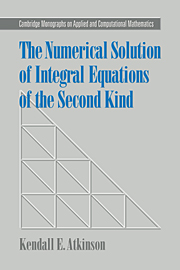Book contents
- Frontmatter
- Contents
- Preface
- 1 A brief discussion of integral equations
- 2 Degenerate kernel methods
- 3 Projection methods
- 4 The Nyström method
- 5 Solving multivariable integral equations
- 6 Iteration methods
- 7 Boundary integral equations on a smooth planar boundary
- 8 Boundary integral equations on a piecewise smooth planar boundary
- 9 Boundary integral equations in three dimensions
- Appendix: Results from functional analysis
- Bibliography
- Index
9 - Boundary integral equations in three dimensions
Published online by Cambridge University Press: 27 March 2010
- Frontmatter
- Contents
- Preface
- 1 A brief discussion of integral equations
- 2 Degenerate kernel methods
- 3 Projection methods
- 4 The Nyström method
- 5 Solving multivariable integral equations
- 6 Iteration methods
- 7 Boundary integral equations on a smooth planar boundary
- 8 Boundary integral equations on a piecewise smooth planar boundary
- 9 Boundary integral equations in three dimensions
- Appendix: Results from functional analysis
- Bibliography
- Index
Summary
The study of boundary integral equation reformulations of Laplace's equation in three dimensions is quite an old one, with the names of many well-known physicists, engineers, and mathematicians associated with it. The development of practical numerical methods for the solution of such boundary integral equations lagged behind and is of more recent vintage, with most of it dating from the mid-1960s. In the 1980s there was an increased interest in the numerical analysis of such equations, and it has been quite an active area of research in the 1990s.
These boundary integral equations are defined on surfaces in space, and there is a far greater variety to such surfaces than is true of boundaries for planar problems. The surfaces may be either smooth or piecewise smooth, and when only piecewise smooth, there is a large variation as to the structure of edges and vertices present on the surface. In addition, most numerical methods require approximations of a piecewise polynomial nature over triangulations of the surface, in the manner developed in Chapter 5. These numerical methods lead to the need to solve very large linear systems, and until recently most computers had great difficulty in handling such problems. The practical aspects of setting up and solving such linear systems are more onerous for boundary integral equations in three dimensions, and this means that the numerical analysis problems of concern are often of a different nature than for planar boundary integral equations.
- Type
- Chapter
- Information
- The Numerical Solution of Integral Equations of the Second Kind , pp. 427 - 515Publisher: Cambridge University PressPrint publication year: 1997



